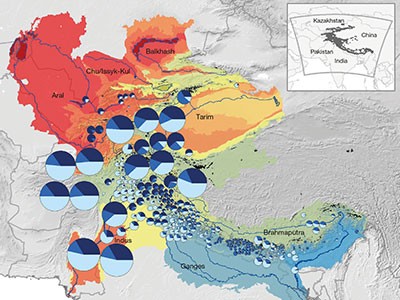
Reanalysing and remodelling of augmented data sets suggest that glaciers in the high mountains of Asia provide enough water to sustain the basic needs of up to 280 million people.Credit: Mantaphoto/Getty
Readers of this week’s Nature might well have a justified feeling of déjà vu. In 2017, we published a modelling paper by Hamish Pritchard entitled ‘Asia’s glaciers are a regionally important buffer against drought’, and today we publish the remarkably similar-sounding ‘Asia’s shrinking glaciers protect large populations from drought stress’, by the same author (H. D. Pritchard Nature 569, 649–654; 2019). As far as we know, for the first time in our history, Nature is effectively republishing a retracted paper. Why?
Shortly after publication of the original paper, sharp-eyed readers noticed an important error in the incorporation and interpretation of a previously published estimate of glacial mass imbalance. We highlighted the nature of the error in an Editorial Expression of Concern (Nature 550, 548; 2017). Because the error turned out to affect several aspects of the paper, including important details of its analytical approach, Pritchard retracted the paper, at our suggestion. In doing so, he became free to essentially go back to the drawing board and do his modelling afresh.
Read the paper: Asia’s shrinking glaciers protect large populations from drought stress
Because, editorially, we continued to be interested in the topic, we were open to resubmission of this work, with the caveat that the paper’s significance and relevance to Nature’s readership would be re-evaluated at that time. It turned out that, on resubmission, the overarching conclusions of the work were largely unchanged, and indeed seemed potentially more impactful, in part because major new data sets had become available in the interim.
The original paper found that glaciers in the high mountains of Asia provided enough water to meet the basic needs of 136 million people; the republished paper is consistent with these results, but includes a range of estimates of those affected that has an upper limit of 280 million people. Following extensive review by the referees, all of whom were familiar with the earlier issues surrounding the work, the revised paper is now being published. For transparency, it provides links to the retracted version.
The present case — in which a paper’s conclusions become even more compelling after retraction and revision — is likely to be exceedingly rare. The process and outcome, however, highlight the range of reasons for retraction. At one extreme lies clear fraud. Somewhere along the continuum are honest mistakes that necessarily undermine a paper’s main conclusions. At the other extreme is the messy reality of modern research, where a complex mix of inputs, models and analysis might yield errors for which a quick correction is neither definitive nor desirable. In such cases, if the initial erroneous paper is retracted and the work redone, republication becomes a possibility, provided that the findings remain sufficiently significant. Today’s case teaches us to look beyond the ‘retraction’ label, and to keep an open mind lest we erase significant new discoveries.

 Read the paper: Asia’s shrinking glaciers protect large populations from drought stress
Read the paper: Asia’s shrinking glaciers protect large populations from drought stress





